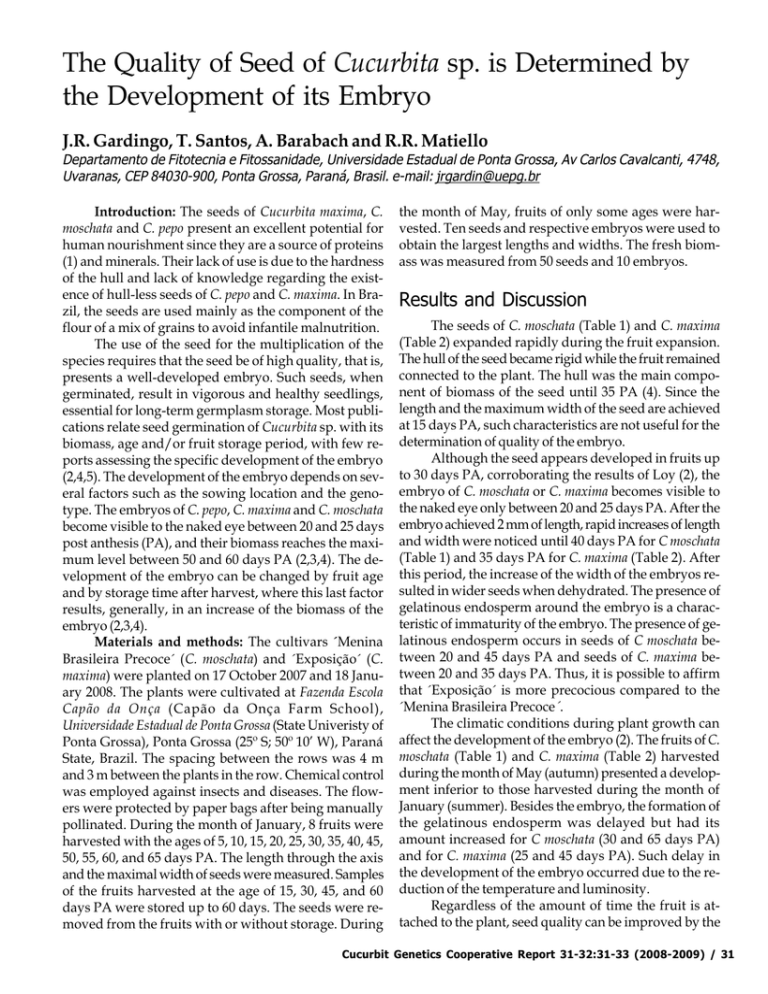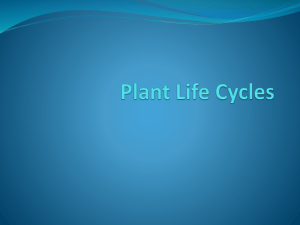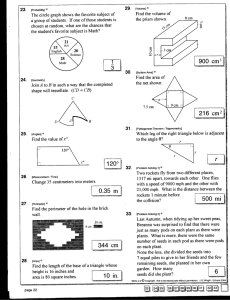Cucurbita the Development of its Embryo
advertisement

The Quality of Seed of Cucurbita sp. is Determined by the Development of its Embryo J.R. Gardingo, T. Santos, A. Barabach and R.R. Matiello Departamento de Fitotecnia e Fitossanidade, Universidade Estadual de Ponta Grossa, Av Carlos Cavalcanti, 4748, Uvaranas, CEP 84030-900, Ponta Grossa, Paraná, Brasil. e-mail: jrgardin@uepg.br Introduction: The seeds of Cucurbita maxima, C. moschata and C. pepo present an excellent potential for human nourishment since they are a source of proteins (1) and minerals. Their lack of use is due to the hardness of the hull and lack of knowledge regarding the existence of hull-less seeds of C. pepo and C. maxima. In Brazil, the seeds are used mainly as the component of the flour of a mix of grains to avoid infantile malnutrition. The use of the seed for the multiplication of the species requires that the seed be of high quality, that is, presents a well-developed embryo. Such seeds, when germinated, result in vigorous and healthy seedlings, essential for long-term germplasm storage. Most publications relate seed germination of Cucurbita sp. with its biomass, age and/or fruit storage period, with few reports assessing the specific development of the embryo (2,4,5). The development of the embryo depends on several factors such as the sowing location and the genotype. The embryos of C. pepo, C. maxima and C. moschata become visible to the naked eye between 20 and 25 days post anthesis (PA), and their biomass reaches the maximum level between 50 and 60 days PA (2,3,4). The development of the embryo can be changed by fruit age and by storage time after harvest, where this last factor results, generally, in an increase of the biomass of the embryo (2,3,4). Materials and methods: The cultivars ´Menina Brasileira Precoce´ (C. moschata) and ´Exposição´ (C. maxima) were planted on 17 October 2007 and 18 January 2008. The plants were cultivated at Fazenda Escola Capão da Onça (Capão da Onça Farm School), Universidade Estadual de Ponta Grossa (State Univeristy of Ponta Grossa), Ponta Grossa (25º S; 50º 10’ W), Paraná State, Brazil. The spacing between the rows was 4 m and 3 m between the plants in the row. Chemical control was employed against insects and diseases. The flowers were protected by paper bags after being manually pollinated. During the month of January, 8 fruits were harvested with the ages of 5, 10, 15, 20, 25, 30, 35, 40, 45, 50, 55, 60, and 65 days PA. The length through the axis and the maximal width of seeds were measured. Samples of the fruits harvested at the age of 15, 30, 45, and 60 days PA were stored up to 60 days. The seeds were removed from the fruits with or without storage. During the month of May, fruits of only some ages were harvested. Ten seeds and respective embryos were used to obtain the largest lengths and widths. The fresh biomass was measured from 50 seeds and 10 embryos. Results and Discussion The seeds of C. moschata (Table 1) and C. maxima (Table 2) expanded rapidly during the fruit expansion. The hull of the seed became rigid while the fruit remained connected to the plant. The hull was the main component of biomass of the seed until 35 PA (4). Since the length and the maximum width of the seed are achieved at 15 days PA, such characteristics are not useful for the determination of quality of the embryo. Although the seed appears developed in fruits up to 30 days PA, corroborating the results of Loy (2), the embryo of C. moschata or C. maxima becomes visible to the naked eye only between 20 and 25 days PA. After the embryo achieved 2 mm of length, rapid increases of length and width were noticed until 40 days PA for C moschata (Table 1) and 35 days PA for C. maxima (Table 2). After this period, the increase of the width of the embryos resulted in wider seeds when dehydrated. The presence of gelatinous endosperm around the embryo is a characteristic of immaturity of the embryo. The presence of gelatinous endosperm occurs in seeds of C moschata between 20 and 45 days PA and seeds of C. maxima between 20 and 35 days PA. Thus, it is possible to affirm that ´Exposição´ is more precocious compared to the ´Menina Brasileira Precoce´. The climatic conditions during plant growth can affect the development of the embryo (2). The fruits of C. moschata (Table 1) and C. maxima (Table 2) harvested during the month of May (autumn) presented a development inferior to those harvested during the month of January (summer). Besides the embryo, the formation of the gelatinous endosperm was delayed but had its amount increased for C moschata (30 and 65 days PA) and for C. maxima (25 and 45 days PA). Such delay in the development of the embryo occurred due to the reduction of the temperature and luminosity. Regardless of the amount of time the fruit is attached to the plant, seed quality can be improved by the Cucurbit Genetics Cooperative Report 31-32:31-33 (2008-2009) / 31 Literature Cited storage of the fruits, resulting in the increase of biomass of the embryo (2,3,4). The fruits of C. moschata and C. maxima harvested 15 days PA presented an increase in the length and width of the embryo during storage time (up to 45 days). Regardless of the storage period used for these fruits, the amount of the seeds and size of the embryos were inferior to those obtained from fruits harvested 30, 45, and 60 days PA under the same conditions. Therefore, the harvest of the fruits 15 days PA for the obtention of seeds is not recommended. The storage of the fruits harvested 15, 30, 45, and 60 days PA resulted in the increase of biomass, benefiting the embryo. The measurement of the length and width of some embryos per fruit is a rapid method for assessing the stage of seed development. The determination of the quality of seed can become more accurate using as auxiliary parameters the determination of the width and dry biomass of the embryo. 1. Jacks, T.J., T.P. Hensarling and L.Y. Yatsu. 1972. Cucurbit seeds: I. Characterizations and uses of oils and proteins. A Review. Econ. Bot. 26: 135-141. 2. Loy, J.B. 2000. Seed development in Cucurbita pepo: An overview with emphasis on hull-less seeded genotypes of pumpkin. Cucurbit Genetics Cooperative Report, 23: 89-95. 3. Santos, T. 2008. Desempenho da qualidade de sementes de abóbora cv Menina Brasileira colhidas em quatro épocas e submetidas a diferentes períodos de armazenamento. 34p. Trabalho de Conclusão de Curso Agronomia. UEPG www.uepg.br/colegiados/colagro/monografias/ TatianeDosSantos.PDF. 4. Barabach, A. 2009. Qualidade de sementes de moranga ‘Exposição’ em função da idade e do armazenamento de frutos. 2009. Trabalho de Conclusão de Curso Agronomia. UEPG. 42p. 5. Nakajima, T. 1962. Physiological studies of seed development, especially embryonic growth and endosperm development. Bull. Univ. Osaka Pref., Ser. B, 13: 13-48. Table 1. Length and width of seeds of embryos of Cucurbita moschata ‘Menina Brasileira Precoce’ obtained from fruits harvested in January (Summer) and May (Autumn) - 2008. Ponta Grossa, Paraná State, Brazil. Days postanthesis 15 20 25 30 35 40 45 50 55 60 65 Summer Seeds Embryos Length¹ Width² Length Width mm mm mm mm 17.3 14.7 14.6 14.6 14.4 14.3 18.6 16.0 16.6 15.9 11.6 10.0 9.9 10.0 10.2 10.3 11.9 10.3 10.7 10.9 * * 4.5 6.1 9.2 10.2 10.5 11.6 13.0 13.0 12.1 3.0 4.5 4.9 7.5 7.8 8.1 8.6 8.9 8.8 Autumn Seeds Length Width mm mm 16.7 14.5 15.6 15.4 22.3 ¹ Length of recently harvested seeds (mm), ² Width of recently harvested seeds (mm) * not visualized by the naked eye - not determined 32 / Cucurbit Genetics Cooperative Report 31-32:31-33 (2008-2009) 8.5 9.3 10.0 10.1 13.9 Embryos Length Width mm mm * * 3.9 10.6 10.9 * * 2.7 7.6 7.7 Table 2. Length and width of seeds of embryos of Cucurbita maxima ‘Exposição’ obtained from fruits harvested in January (Summer) and May (Autumn) - 2008. Ponta Grossa, Paraná State, Brazil. Days postanthesis 5 10 15 20 25 30 35 40 45 50 55 60 Summer Seeds Embryos Length¹ Width² Length Width mm mm mm mm 6.3 14.1 16.6 15.7 16.5 16.2 16.8 16.6 15.7 16.9 16.0 16.0 3.5 9.9 11.4 11.1 11.3 11.5 11.5 11.2 11.0 11.3 10.3 10.8 * * * 1.8 8.9 13.1 13.9 14.2 14.2 14.4 14.4 14.0 * * * 1.3 5.8 8.9 9.6 9.6 9.8 9.7 9.3 10.0 Autumn Seeds Length Width mm mm 16.1 16.7 15.7 17.2 15.2 10.8 10.6 9.8 9.7 10.5 Embryos length Width mm mm 4.1 4.8 14.2 12.8 2.2 2.8 7.3 8.9 ¹ Length of recently harvested seeds (mm), ² Width of recently harvested seeds (mm) * not visualized in the naked eye - not determined Cucurbit Genetics Cooperative Report 31-32:31-33 (2008-2009) / 33






